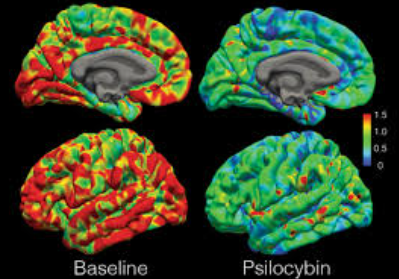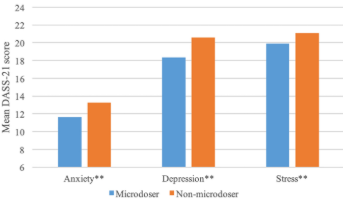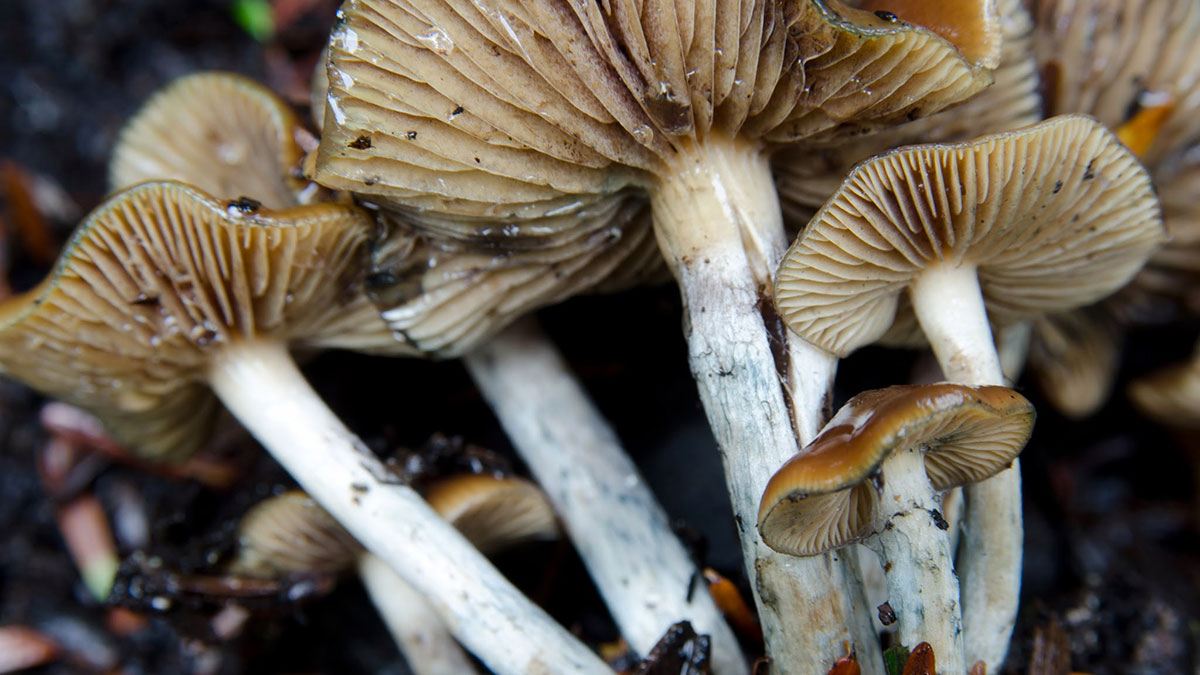Do psychedelics cure cancer? No. Do some of them help with psychiatric care? Yes. Various cultures have used psychedelics for thousands of years, some of the earliest examples being “Magic Mushrooms” in cave paintings in Spain and Northern Africa that date back to 9000 B.C. During the 1960s, psilocybin, the proper name of “Magic Mushrooms,” was seen as a wonder drug that could cure anything from addiction to anxiety. Now, some psychedelics like psilocybin, are used for drug-assisted therapy and are prescribed by psychiatrists. These drugs, while seemingly risky, have shown a massive benefit to the mental health of patients. The many expert opinions on these types of drugs should be reason to believe that the hallucinogens should be legalized for psychiatric care on patients. The legalization of certain psychedelic drugs should be heavily considered for mental health care due to their massive positive therapeutic impact.
To understand how certain psychedelics could be used productively, we first have to understand how they alter the brain. Psilocybin, for example, is a very popular psychedelic drug, only legal in California, Colorado, Washington D.C., and Maine. Psilocybin temporarily alters a person’s mood, thoughts, and perceptions. Researchers have discovered that psilocybin temporarily disrupts a brain network involved in creating a person’s sense of self. It causes many changes in the brain’s functional connectivity which is a measure of how activity in different regions of the brain is correlated throughout the brain. Psilocybin usually induces the largest amount of changes in the “default mode” network. This is the network of the brain where we are usually in where we aren’t focused on a specific task. It governs people’s sense of space, time, and self. This effect in the default mode in the brain could greatly improve patients with severe anxiety and existential distress due to the relaxation effect. Psilocybin is one of the many drugs that could be a therapy for things like depression and PTSD, as well as MDMA (ecstasy). They work by encouraging new connections between neurons in the brain which is called plasticity.
Several studies directed by highly credible researchers have been conducted over the years about how certain psychedelic drugs affect different types of people with different types of conditions. For example, a research team led by Dr. Joshua Siegel, a professor at Washington University, used functional magnetic resonance imaging (fMRI) to track changes in brain activity related to the use of psilocybin. He gathered seven young and healthy adults to participate in the study, which involved regular fMRI sessions before, during, and after a carefully controlled dose of psilocybin. The scans concluded that psilocybin caused quick and dramatic changes in brain networks.
Siegal expressed that neurons in a network fire at the same time. He concluded from the study that populations of neurons that are normally in synchrony are out of synchrony. Another study was conducted by Dr. David Olson from the University of California on the subject of psychedelic drugs. Olson and his team set out to understand how to activate the pathways for brain plasticity safely while also avoiding hallucinogenic effects. In the case of previous studies such as Siegal’s, psychedelic drugs encourage plasticity by binding to a cellular receptor in neurons called the 5-hydroxytryptamine 2A receptor (5-HT2AR). However, other compounds that bind to 5-HT2AR don’t promote plasticity. The team first tested the properties of compounds that bind to 5-HT2ARs. They discovered that a compound’s ability to enter a neuron’s membrane and get inside the cell, rather than its ability to activate 5- HT2AR, predicted how well it grew structures called dendritic spines. Compounds that were able to cross into the neurons and form dendritic spines were different from compounds like serotonin, which were not able to cause hallucinogenic effects. The non-hallucinogenic compounds were not able to form these dendritic spines. The results suggest that the 5-HT2ARs inside and outside of neurons activate different cell-signaling pathways. The team wanted to see if a similar phenomenon could be detected in living brains, so they used mice engineered to make a protein that can bring serotonin into neurons. When they were treated with a drug to increase serotonin levels in one part of the brain, the neurons formed substantially more dendritic spines than in mice without the protein. They also showed improvements in behavior tests relevant to depression.
HT2AR, predicted how well it grew structures called dendritic spines. Compounds that were able to cross into the neurons and form dendritic spines were different from compounds like serotonin, which were not able to cause hallucinogenic effects. The non-hallucinogenic compounds were not able to form these dendritic spines. The results suggest that the 5-HT2ARs inside and outside of neurons activate different cell-signaling pathways. The team wanted to see if a similar phenomenon could be detected in living brains, so they used mice engineered to make a protein that can bring serotonin into neurons. When they were treated with a drug to increase serotonin levels in one part of the brain, the neurons formed substantially more dendritic spines than in mice without the protein. They also showed improvements in behavior tests relevant to depression.
While psychedelics are highly beneficial to psychiatric care, there are negative stigmas associated with their use. For example, opponents of these hallucinogens are generally concerned about the dependency patients might develop after they continue using them. The risk of becoming addicted to the drugs is a major concern when patients are unable to overcome their disorder without the use of the psychedelics. However, according to the National Institute of Drug Abuse (NIDA), taking psychedelic drugs “typically does not lead to addiction.” With psychedelics, there is also always a risk of a “bad trip,” a sensation that can occur when someone is on hallucinogens where their body reacts negatively to the drug and fills the body with paranoia. If this happens while a patient is in a crucial step in their care, it may revert some progress and harm the user.
Abuse (NIDA), taking psychedelic drugs “typically does not lead to addiction.” With psychedelics, there is also always a risk of a “bad trip,” a sensation that can occur when someone is on hallucinogens where their body reacts negatively to the drug and fills the body with paranoia. If this happens while a patient is in a crucial step in their care, it may revert some progress and harm the user.
While it is difficult to eliminate the risk of a bad trip completely, there are still ways to work against it, such as being in a safe, peaceful location, remaining calm, having a friend nearby, and listening to calming music. There are also several more risks that all patients should be aware of before taking their treatment, such as drowsiness, dizziness, sexual dysfunction, weight gain, dry mouth, and mood changes, as well as more serious complications like allergic reactions, suicidal ideation, seizures, and drug interactions. Yet, in a study by the National Library of Medicine, less than 1% of users reported any long-lasting negative effects. The low risk does not outweigh the potential outcome of the reversal of progress, yet it can still be negated by other factors and the severity of the “bad trip.”
The idea of it being unethical to use psychedelics is archaic at best as it limits people’s options while a whole new way is possible. Alternative care has been on the rise and the stigma against it is slowly fading, so with the increase in non-standard medicine, will psychedelics be next? Although there is still a stigma against psychedelics and how the risks of them could be detrimental to people’s health, the same used to be said about how alternative care also could be risky to people’s health. As more people use alternative care and begin to trust it more and more, the use of psychedelics could relate heavily to alternative care in the near future, only if psychedelics are legalized. People could also begin to trust it more as more people use it for certain disorders. Will they finally be allowed to reach those who need them most? Not for a while, but as the stigma dies, so will the fight against it.
In fact, psychedelics are legalized in various countries, like Canada, for religious and ceremonial purposes. In these ceremonies, many of which have been safely practiced for hundreds of years, the participant or participants will consume one of many different types of psychedelics. Many of these ceremonies use Ayahuasca, a psychoactive beverage in Central and South America, as a means to achieve a higher state of being or higher knowledge. Due to its use as far back as 900 B.C. with the Chavin people of Peru through their Shamans. Ayahuasca is a relatively easy drug to procure and produce, only needing two main ingredients, which is why it’s so commonly used recreationally and in scams done by fake shamans to trick Westerners into spending money. Common effects of using this drug are relaxation and serenity, allowing one to meditate and reach a “higher state.”
beverage in Central and South America, as a means to achieve a higher state of being or higher knowledge. Due to its use as far back as 900 B.C. with the Chavin people of Peru through their Shamans. Ayahuasca is a relatively easy drug to procure and produce, only needing two main ingredients, which is why it’s so commonly used recreationally and in scams done by fake shamans to trick Westerners into spending money. Common effects of using this drug are relaxation and serenity, allowing one to meditate and reach a “higher state.”
The use of psychedelic drugs should be widely considered for legalization for mental diseases because of their highly regarded therapeutic impact on them. The countless studies and proven benefits of these drugs should be substantial evidence as to why some of them should be legalized. The benefits greatly outweigh the risks, and psychedelics being legalized could help countless people. Even credible professors back up that these hallucinogens are safe to use and that the risks of them being dangerous are extremely low. The amount of scientific research done on these certain types of drugs to the point that various scientists and medical professionals approve and are in favor of legalizing these hallucinogenic drugs should be very convincing as to why these drugs should be legalized for psychiatric care. So even though none of them will cure the world’s worst diseases, they would be a small step forward to improving psychiatric care in patients with mental disorders.


